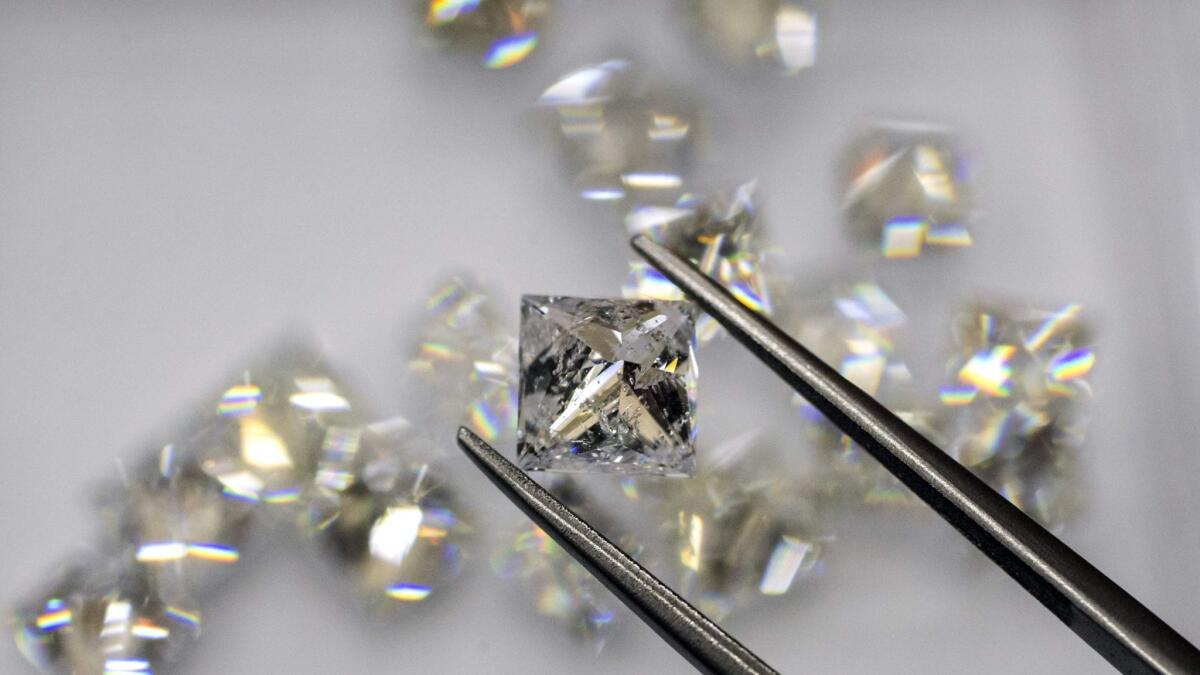What scientists found trapped in a diamond: a type of ice not known on Earth

- Share via
Trapped in the rigid structure of diamonds formed deep in the Earth’s crust, scientists have discovered a form of water ice that was not previously known to occur naturally on our planet.
The finding, published Thursday in Science, represents the first detection of naturally occurring ice-VII ever found on Earth. And as sometimes happens in the scientific process, it was discovered entirely by accident.
Ice-VII is about one-and-a-half times as dense as the regular ice we put in our drinks and skate on in winter, and the crystalline structure of its atoms is different as well.
In normal ice, known as ice-I, the oxygen atoms arrange themselves in a hexagonal shape. In ice-VII these atoms are arranged in a cubic shape.
Oliver Tschauner, a professor of geoscience at the University of Nevada, Las Vegas, explained that there are actually several known phases of water ice that form under different pressure and temperature conditions.
That’s unusual. Generally, when you subject a solid phase of matter to increasing amounts of pressure, the space between the chemical bonds will decrease a little, and the bonds will tilt slightly toward each other, said Tschauner, who led the new work. That’s called compressibility.
But water ice has very low compressibility. When it gets subjected to too much pressure, the atoms don’t scooch together. Instead, they rearrange themselves into different patterns.
For example, if you press down hard enough on ice-I, it will transform into ice-II, which has a rhombohedral structure. Increase the pressure once again and the atoms will rearrange themselves into ice-III, then IV, V, VI and VII.
Unlike the other phases of ice, however, ice-VII remains fairly stable even as the pressure increases.
Scientists believe that ice-VII may be found in great abundance in the solar system, perhaps in the interior of ice moons like Enceladus and Europa, or as part of the ocean floor of Titan. But they did not think it could naturally occur on Earth.
The pressures ice-VII requires to form can be found on our planet, but they exist only deep in the mantle where the temperature is too warm for this form of ice to be stable.
Previous work has shown that ice-VII can be synthesized in the lab, but the new study revealed that small amounts of the material can also form naturally here on Earth, thanks to the peculiar properties of diamonds.
Diamonds can form very deep in the Earth’s mantle, as much as 400 miles beneath the crust. As part of their formation process they will occasionally encapsulate teeny bits of the chemical environment around them in what are called inclusions.
The natural convection of the mantle will eventually transport a portion of these diamonds to the surface of the Earth. When that happens, they also bring up other deep-Earth materials in the form of these inclusions.
What’s special about inclusions in diamonds is that the material entrapped within them remains under the same pressure as it was during the time it was encapsulated.
“The diamond lattice doesn’t relax much, so the volume of the inclusion remains almost constant whether it’s in the Earth’s mantle or in your hand,” Tschauner said.
Because of this property, diamonds are the major source of samples from the deep Earth, said George Rossman, a mineralogist at Caltech who worked on the study.
“Usually the extremely deep minerals that come up to the surface are not stable once they experience low pressures,” Rossman said. “They crack and whatever inclusions they had in them are lost. But if a diamond comes up fast enough, it doesn’t change.”
Diamonds that form in the Earth’s mantle don’t originally capture ice-VII. As you’ll recall, the mantle is too warm for ice-VII to exist.
However, as the authors discovered, diamonds can trap small bubbles of extremely dense pressurized water when they form. Then, as the diamond moves up through the mantle, the water inclusion is subjected to cooler temperatures while remaining under the same pressurized conditions. In that very specific case, ice-VII can occur.
Tschauner candidly admits that he and his team did not intentionally set out to look for ice-VII in diamonds. Instead, they were hunting for an unusual phase of carbon dioxide.
But while they were scanning the diamonds with high intensity X-rays, they saw something else: The first conclusive evidence of ice-VII on the planet.
“We were all very excited about that,” Tschauner said.
Thanks to their discovery, ice-VII has been recognized for the first time as a mineral by the International Mineralogical Assn.
Rossman said that finding ice-VII, even by accident, was a thrill for the whole team.
“Water in diamonds is not unknown, but finding this very high pressure form of water ice intact, that was really fortuitous,” he said. ‘That’s what you call discovery.”
Do you love science? I do! Follow me @DeborahNetburn and “like” Los Angeles Times Science & Health on Facebook.
MORE IN SCIENCE
On Twitter, fake news spreads faster and further than real news — and bots aren’t to blame
Brain tissue samples from people of all ages suggest we stop growing new neurons in our early teens
What you can learn about marriage and migration from a 13-million member family tree





